Fall Protection on Scaffolding: Your Ultimate Guide to Worker Safety
Introduction
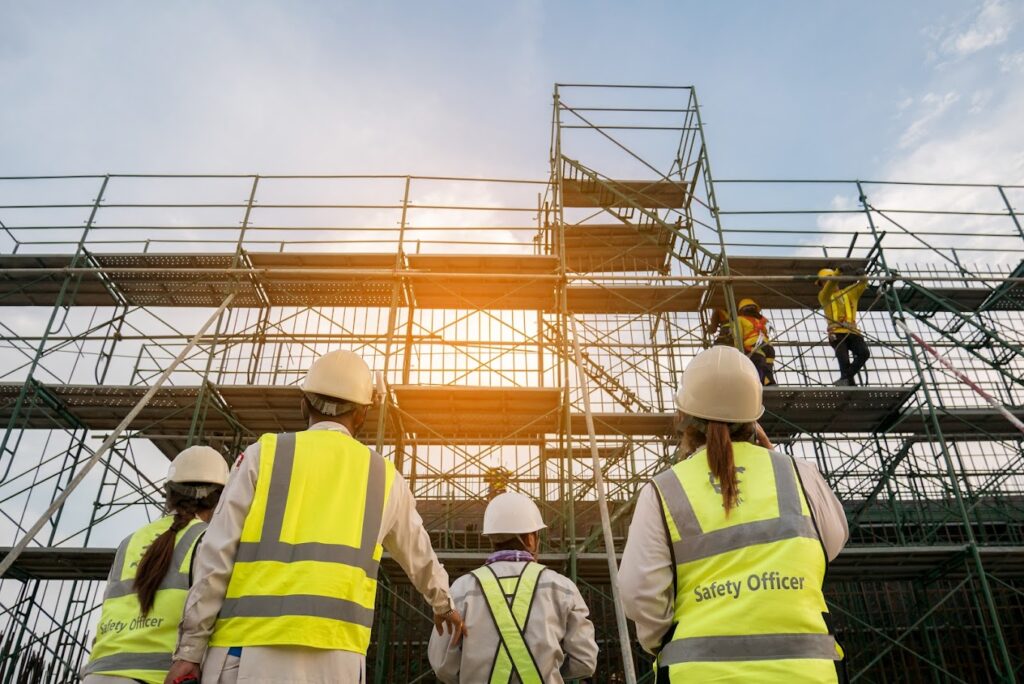
The construction industry is no stranger to danger. Among the many risks workers face, falls from scaffolding stand out as a leading cause of injuries and fatalities. In fact, falls account for a staggering number of construction-related accidents each year. The impact of these incidents is devastating, not only for the workers involved but also for their families, employers, and the project itself.
But here’s the good news: the vast majority of these accidents are preventable. By implementing proper fall protection measures, we can drastically reduce the risk of falls and create a safer working environment for everyone on the job site. This comprehensive guide will delve into everything you need to know about scaffolding fall protection, equipping you with the knowledge to prioritize safety and protect your team.
Understanding the Risks: Why Fall Protection is Non-Negotiable
Scaffolding, while essential for accessing elevated work areas, presents a variety of hazards that can quickly turn dangerous.
- Falls from Heights: The most obvious risk is falling from the elevated platform, leading to severe injuries or even death.
- Falling Objects: Tools, materials, or debris can fall from scaffolding, striking workers below. Head injuries are a common and serious consequence.
- Scaffold Collapses: Improperly constructed or overloaded scaffolds can collapse, putting everyone in the vicinity at risk.
- Electrocution: If scaffolding is too close to power lines, workers can be electrocuted.
The consequences of these hazards extend far beyond physical injuries. Falls can lead to:
- Lost Time and Productivity: Injured workers mean project delays and increased costs.
- Financial Burden: Medical expenses, workers’ compensation claims, and potential lawsuits can be financially crippling.
- Legal Consequences: Failure to provide adequate fall protection can result in fines, penalties, and even criminal charges.
- Reputational Damage: Accidents tarnish a company’s reputation and make it harder to attract skilled workers.
In Canada, the Occupational Health and Safety Act (OHSA) and associated regulations mandate specific fall protection requirements for scaffolding. These regulations outline minimum safety standards and procedures that employers must follow to protect workers from falls.
Key Components of a Scaffolding Fall Protection System
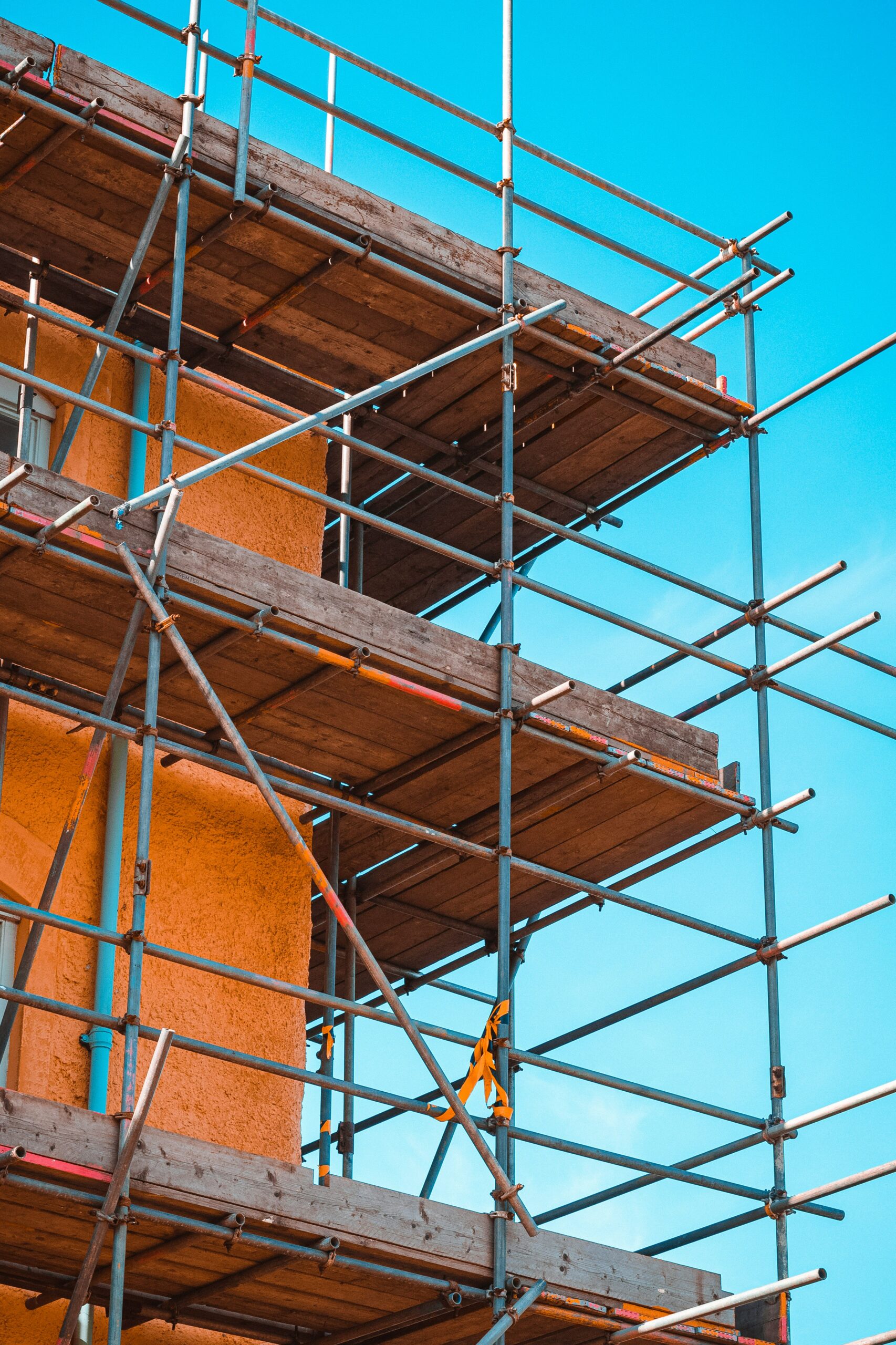
To safeguard workers on scaffolding, a robust fall protection system is essential. This system typically comprises three key components: guardrails, personal fall arrest systems (PFAS), and safety nets.
Guardrails
- Function: Guardrails act as a physical barrier, preventing workers from falling off the edge of the scaffolding.
- Components: Guardrails consist of top rails, mid rails, and toe boards.
- Top Rails: Positioned approximately 42 inches above the working platform, top rails are the primary barrier against falls.
- Mid Rails: Installed halfway between the top rail and the platform, mid rails add an extra layer of protection.
- Toe Boards: Attached to the scaffold platform, toe boards prevent tools and materials from falling and potentially causing injuries below.
- Installation: Guardrails must be properly installed and secured according to the manufacturer’s instructions and relevant safety regulations. They should be able to withstand significant force to ensure worker safety.
Personal Fall Arrest Systems (PFAS)
- Function: PFAS provide a backup in case a worker falls over a guardrail or if guardrails are not feasible.
- Components: PFAS include a body harness, lanyard, lifeline, and anchor points.
- Body Harness: Distributes fall forces across the worker’s body, preventing serious injury.
- Lanyard: Connects the harness to the lifeline or anchor point.
- Lifeline: A flexible line that allows the worker to move along the scaffold while remaining connected to an anchor point.
- Anchor Points: Secure points on the structure or scaffold capable of supporting the force of a fall.
- How PFAS Works: If a worker falls, the PFAS arrests the fall, preventing them from hitting the ground. The system absorbs the energy of the fall, reducing the impact on the worker’s body.
Safety Nets
- Function: Safety nets are designed to catch workers who fall from scaffolding, preventing them from hitting the ground or lower levels.
- Usage: Safety nets are typically used as a secondary form of fall protection when other measures like guardrails or PFAS are not feasible or practical.
- Installation: Safety nets must be installed correctly and inspected regularly to ensure they are in good working order. They should be positioned as close as possible to the work surface to minimize the distance of a potential fall.
By understanding the key components of a scaffolding fall protection system and how they work together, you can make informed decisions about the best ways to protect your workers and ensure a safe working environment.
Choosing the Right Fall Protection Equipment
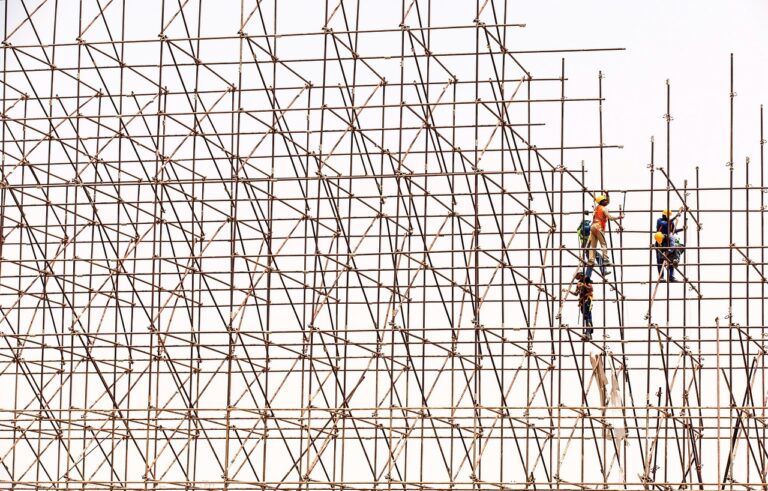
Selecting the appropriate fall protection equipment is crucial for ensuring worker safety on scaffolding. Here’s a breakdown of the key considerations for choosing the right gear:
Harness Selection
- Proper Fit: A well-fitted harness is essential for distributing fall forces evenly across the body and preventing injury. Harnesses should be snug but not restrictive, allowing for freedom of movement.
- Weight Capacity: Ensure the harness is rated for the worker’s weight, including any tools or equipment they may be carrying.
- Types of Harnesses:
- Full-Body Harness: Offers the most comprehensive protection and is typically the preferred choice for scaffolding work.
- Sit Harness: Primarily used for positioning and restraint applications, and less suitable for fall arrest.
- Inspection and Maintenance: Regularly inspect harnesses for signs of wear, tear, or damage. Replace any damaged or worn-out harnesses immediately.
Lanyard and Lifeline Options
- Shock-Absorbing Lanyards: These lanyards are designed to stretch and absorb the energy of a fall, reducing the forces exerted on the worker’s body. They are a standard choice for fall arrest systems.
- Non-Shock-Absorbing Lanyards: These lanyards do not stretch and are typically used for positioning or restraint applications, where the worker is not expected to fall.
- Rope Lifelines: Rope lifelines are lightweight and flexible, making them ideal for work on scaffolds where mobility is important.
- Cable Lifelines: Cable lifelines are more durable and resistant to abrasion, making them suitable for heavy-duty applications or environments with potential hazards.
Anchor Point Considerations
- Strength Requirements: Anchor points must be capable of withstanding the forces generated during a fall. They should be rated for the appropriate weight capacity and meet or exceed industry standards.
- Proper Attachment: Always follow the manufacturer’s instructions and best practices for attaching lanyards or lifelines to the designated anchor points.
Scaffolding Safety Best Practices
Implementing best practices is crucial for maximizing worker safety on scaffolding. Here are essential tips to follow:
Pre-Use Inspection
Before each use, a competent person should conduct a thorough inspection of the scaffolding. This includes checking for:
- Structural Integrity: Ensure all components are in good condition, free of cracks, rust, or other damage.
- Stability: Check that the scaffold is level, plumb, and properly braced.
- Guardrails and Toe Boards: Verify that they are securely in place and meet height requirements.
- Fall Protection Equipment: Inspect harnesses, lanyards, lifelines, and anchor points for any signs of wear or damage.
- Weather Conditions: Assess wind speeds, precipitation, and other weather conditions that could impact scaffold safety.
- Surrounding Hazards: Identify any potential hazards in the vicinity, such as power lines, traffic, or unstable ground.
Training and Certification
Proper training is a cornerstone of scaffolding safety, especially in Ontario, where “Working at Heights” (WAH) training is mandatory for anyone working on scaffolding or other elevated platforms.
- Working at Heights Training: WAH training covers fall hazards, fall protection systems, and rescue procedures. In Ontario, successful completion of an approved WAH training program is a legal requirement for most workers who work at heights.
- Erectors and Dismantlers: Workers responsible for assembling and dismantling scaffolding should have specialized training in scaffold erection and inspection, as well as WAH certification.
- Scaffold Users: All workers who use scaffolding must also be WAH certified. This training equips them with the knowledge and skills to recognize hazards, use fall protection equipment correctly, and respond appropriately in emergencies.
- Refresher Training: WAH certification typically requires periodic refresher courses to keep workers’ knowledge up-to-date and reinforce safe practices.
- Employer Responsibilities: Employers are responsible for ensuring that their workers are properly trained and certified to work at heights.
By prioritizing WAH training and ensuring that all workers are certified, you not only comply with legal requirements but also create a safer work environment where everyone understands the risks and how to mitigate them.
Loading and Unloading
- Safe Practices: Use designated access points, such as ladders or stair towers, to get on and off the scaffold. Avoid climbing on the frame or using cross braces.
- Weight Restrictions: Never overload the scaffold beyond its rated capacity. Distribute loads evenly across the platform.
- Material Handling: Use hoists or other mechanical means to lift heavy materials onto the scaffold. Avoid throwing or dropping materials.
Weather Considerations
- Wind: High winds can destabilize scaffolding and create a significant fall hazard. Suspend work if wind speeds exceed manufacturer recommendations or safety guidelines.
- Rain, Snow, and Ice: Wet or slippery surfaces increase the risk of falls. Take precautions to clear snow and ice, and use slip-resistant footwear.
- Extreme Temperatures: Extreme heat or cold can affect the integrity of scaffolding materials and worker performance. Adjust work schedules and provide adequate hydration and protective clothing.
Rescue Planning
Develop a rescue plan in case of a fall.
- Procedure: The plan should outline the steps to be taken to rescue a fallen worker, including how to access the worker, provide first aid, and transport them to safety.
- Trained Personnel: Ensure that at least one trained rescuer is on site at all times.
- Equipment: Have the necessary rescue equipment readily available, such as a rescue harness, rope, and descent device.
- Communication: Establish a clear communication system to alert emergency responders and coordinate rescue efforts.
By adhering to these best practices, you can significantly reduce the risk of falls and create a safer working environment for everyone on your scaffolding projects.
Toronto-Specific Considerations
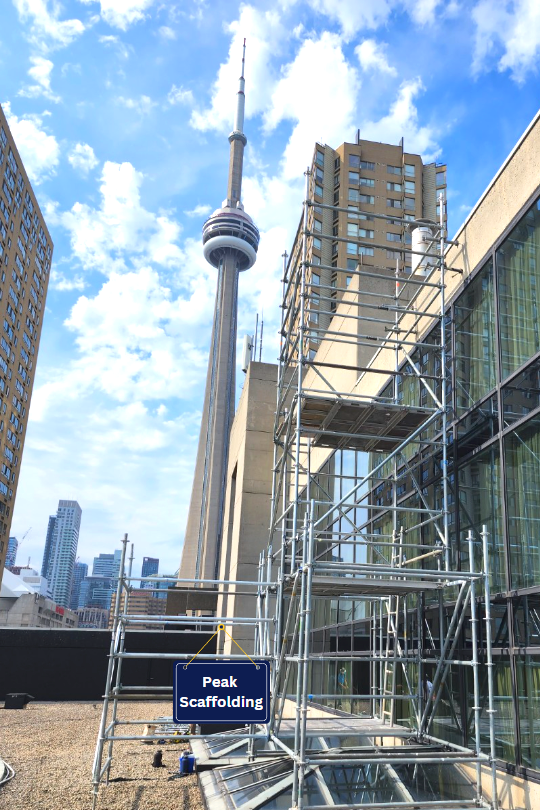
While the fundamental principles of fall protection remain consistent, there are some unique considerations for scaffolding projects in Toronto that you should be aware of.
Local Regulations
In addition to the federal and provincial regulations outlined in the Occupational Health and Safety Act (OHSA), the City of Toronto may have specific bylaws or guidelines related to scaffolding. These could include:
- Permit Requirements: Depending on the size and complexity of your project, you may need to obtain a permit for scaffolding erection.
- Sidewalk and Roadway Access: Scaffolding may impact pedestrian and vehicle traffic, requiring permits or specific safety measures to ensure public safety.
- Heritage Buildings: If your project involves a heritage building, there may be additional restrictions or requirements related to scaffolding installation.
Be sure to check with the City of Toronto’s Building Department or a qualified safety professional to ensure your project complies with all local regulations and guidelines.
Weather Challenges
Toronto’s weather can be unpredictable, with sudden storms, temperature fluctuations, and heavy snowfall in the winter. These conditions can pose additional challenges for scaffolding safety.
- Wind: Toronto is known for its gusty winds, which can destabilize scaffolding. Be prepared to adjust work schedules or temporarily suspend operations during high winds.
- Rain and Snow: Wet or icy conditions can make scaffolding surfaces slippery, increasing the risk of falls. Ensure that workers have appropriate footwear and that platforms are cleared of snow and ice.
- Temperature Extremes: Extreme cold can make scaffolding materials brittle, while extreme heat can cause workers to become dehydrated and fatigued. Monitor weather forecasts and adjust work schedules accordingly.
By being aware of these Toronto-specific factors and taking the necessary precautions, you can minimize the risks associated with weather conditions and ensure worker safety throughout your scaffolding projects.
Common Fall Protection Mistakes (and How to Avoid Them)
Even with the best equipment and training, mistakes can happen. Let’s look at some common fall protection errors and how to prevent them:
- Improperly Fitted Harnesses:
- The Mistake: Harnesses that are too loose or too tight can fail to distribute fall forces properly, leading to serious injury.
- The Fix: Ensure every worker is trained on how to properly adjust their harness and conduct a fit check before each use. Regular inspections should also verify that harnesses remain in good condition.
- Not Using Fall Protection for Short-Duration Tasks:
- The Mistake: Workers sometimes skip fall protection for quick tasks, assuming they won’t fall.
- The Fix: Fall protection should be used at all times when working at height, regardless of task duration. Even a short fall can have devastating consequences.
- Using Damaged or Worn-Out Equipment:
- The Mistake: Worn or damaged equipment may not function properly in the event of a fall.
- The Fix: Inspect all fall protection equipment before each use. Retire any gear that shows signs of wear, damage, or has been involved in a fall.
- Ignoring Weather Warnings:
- The Mistake: Working in adverse weather conditions (high winds, rain, snow, ice) increases the risk of falls.
- The Fix: Monitor weather forecasts and suspend work when conditions become unsafe. Train workers on how to recognize and respond to weather-related hazards.
- Insufficient Training or Lack of Supervision:
- The Mistake: Workers who lack proper training or are not adequately supervised are more likely to make mistakes that can lead to falls.
- The Fix: Ensure all workers receive comprehensive training on fall protection and scaffold safety. Provide ongoing supervision and refresher courses as needed.
- Incorrect Anchor Point Selection:
- The Mistake: Choosing weak or unsuitable anchor points can compromise the entire fall arrest system.
- The Fix: Always select anchor points that meet or exceed the required strength and are specifically designed for fall arrest. Refer to the scaffold manufacturer’s guidelines and consult with a qualified professional if needed.
By recognizing these common mistakes and taking proactive steps to avoid them, you can significantly enhance the safety of your scaffolding operations. Remember, a well-informed and vigilant workforce is your best defence against falls.
Conclusion
In the bustling construction landscape of Toronto, prioritizing fall protection on scaffolding is not merely a best practice—it’s a non-negotiable necessity. The risks associated with falls are far too great to ignore, both in terms of human suffering and the financial and legal repercussions for businesses.
As we’ve explored in this guide, a multi-layered approach is crucial for ensuring worker safety. This involves:
- Understanding the Risks: Recognizing the various hazards associated with scaffolding work, from falls to falling objects and collapses.
- Investing in Quality Equipment: Selecting the right fall protection equipment, including harnesses, lanyards, lifelines, and anchor points.
- Implementing Best Practices: Adhering to safety guidelines, conducting thorough inspections, providing comprehensive training, and developing rescue plans.
- Considering Toronto-Specific Factors: Adapting to local regulations and weather challenges.
- Embracing Technology: Utilizing innovations like wearable tech, drones, and VR training to enhance safety measures.
Remember, fall protection is an investment, not an expense. By prioritizing safety, you not only protect your most valuable asset—your workers—but also ensure the smooth progress and successful completion of your projects.
If you’re seeking a reliable partner for your scaffolding needs in Toronto, consider partnering with PEAK Scaffolding. With our unwavering commitment to safety, expertise in fall protection, and dedication to quality, we can help you create a safe and productive work environment for your team.
Don’t leave worker safety to chance. Take the necessary steps today to implement robust fall protection measures on your scaffolding projects. After all, a safe workplace is a successful workplace.
Related Posts
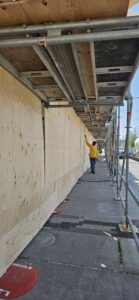
Toronto Scaffolding Permit Guide
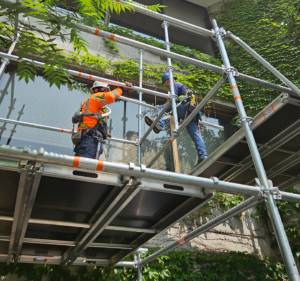
Why Toronto Contractors Choose Ringlock Scaffolding
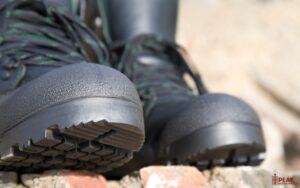
Scaffolding PPE in Ontario: Interactive Guide


